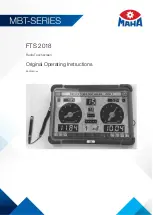
20
21
Table of contents
1. Application
21
2. Safety precautions
21
3. Errors and load restrictions
21
4. Safety regulations
22
5. Ex-data
22
6. Technical data and specifications
23
7. Functional description
24
8. Repairs
27
9. Cleaning, maintenance and storage
27
10. Disposal
27
11. Warranty and liability
28
12. EC-Declaration of conformity
30
13. EC-type-examination certificate
32
note:
the current operating instructions, the declaration of ec
conformity and the ex-certificate are available for down-
load from the relevant product page under www.ecom-ex.
com, or alternatively they can be requested directly from
the manufacturer.
1. Application
The Ex-DT 12 is a multi-purpose testing device for calcula-
ting resistances, capacities and inductance for potentially
explosive areas of Zones 2 and 1 in accordance with direc-
tive 1999/92/EC (ATEX 137). Reading are indicated in the
form of visual and acoustic signals.
2. Safety precautions
This Owner’s Manual contains information and safety regu-
lations which must be followed to ensure safe and reliable
operation of the device under the described conditions.
Failure to follow the information and instructions contained
in this manual can have dangerous consequences or may
contravene applicable legislation.
Please take the time to carefully read through the owner’s
manual before you start using the device. In case of any
doubt (in form of translation or printing errors) the German
language operating instructions shall apply.
3. Errors and load restrictions
If there is any risk that the safety or integrity of the device
has been compromised, then the device must be taken out
of operation immediately and removed from the ex-area
without delay. Action must be taken to prevent the device
from being accidentally taken into operation again.
We recommend that the device should be sent to the
manufacturer to be examined.
The safety and reliability of the device may be at risk if,
for example:
- visible damage is evident on the device,
- visible damage is evident on the connecting cable,
- the device has been subjected to excessive loads for
which it is not designed,
- the device has been improperly stored,
- the device has been damaged in transit,
- inscriptions or lettering on the device are illegible,
- malfunctions occur,
- permitted tolerances or threshold values are exceeded.












































